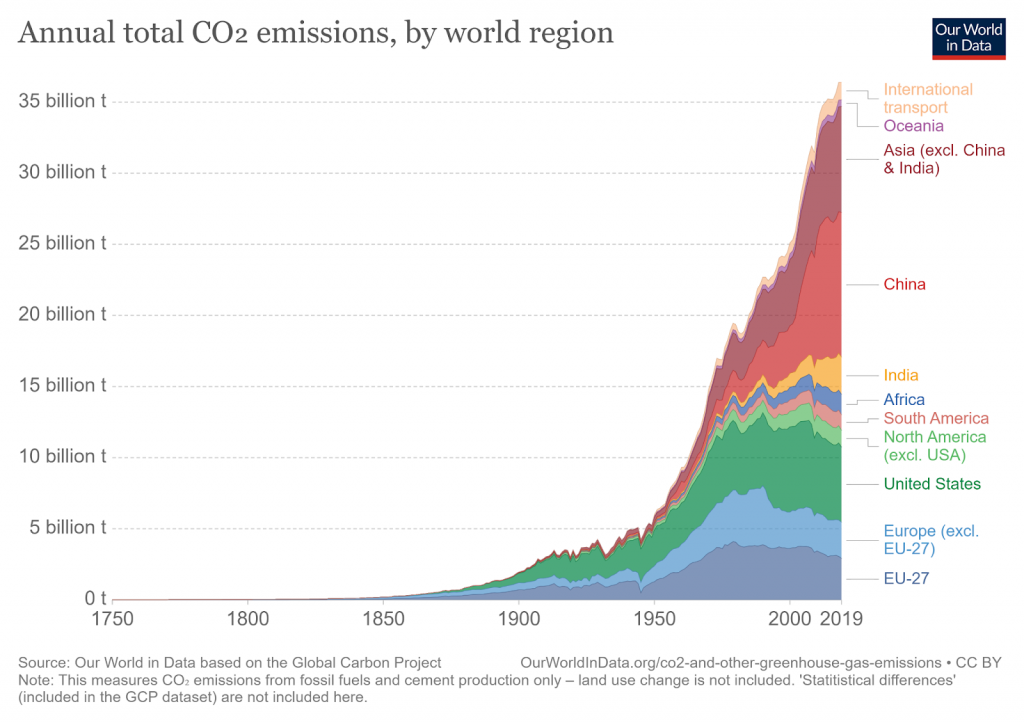Do Carbon Offsets Reduce Climate Change? The Big Picture
Impactful Ninja is reader-supported. When you buy through links on our site, we may earn an affiliate commission.
Learn more
Learn more
.
Hey fellow impactful ninja ? You may have noticed that Impactful Ninja is all about providing helpful information to make a positive impact on the world and society. And that we love to link back to where we found all the information for each of our posts. Most of these links are informational-based for you to check out their primary sources with one click. But some of these links are so-called "affiliate links" to products that we recommend. First and foremost, because we believe that they add value to you. For example, when we wrote a post about the environmental impact of long showers, we came across an EPA recommendation to use WaterSense showerheads. So we linked to where you can find them. Or, for many of our posts, we also link to our favorite books on that topic so that you can get a much more holistic overview than one single blog post could provide. And when there is an affiliate program for these products, we sign up for it. For example, as Amazon Associates, we earn from qualifying purchases. First, and most importantly, we still only recommend products that we believe add value for you. When you buy something through one of our affiliate links, we may earn a small commission - but at no additional costs to you. And when you buy something through a link that is not an affiliate link, we won’t receive any commission but we’ll still be happy to have helped you. When we find products that we believe add value to you and the seller has an affiliate program, we sign up for it. When you buy something through one of our affiliate links, we may earn a small commission (at no extra costs to you). And at this point in time, all money is reinvested in sharing the most helpful content with you. This includes all operating costs for running this site and the content creation itself. You may have noticed by the way Impactful Ninja is operated that money is not the driving factor behind it. It is a passion project of mine and I love to share helpful information with you to make a positive impact on the world and society. However, it's a project in that I invest a lot of time and also quite some money. Eventually, my dream is to one day turn this passion project into my full-time job and provide even more helpful information. But that's still a long time to go. Stay impactful,Affiliate Disclosure
Why do we add these product links?
What do these affiliate links mean for you?
What do these affiliate links mean for us?
What does this mean for me personally?
![]()
Reducing carbon emissions to mitigate climate change is crucial if we want to ensure a sustainable planet for future generations. Carbon offsets are one way to achieve this; however, some assert they do not really work due to various issues involving effectiveness, credibility, and success rates. So, we had to ask: do carbon offsets reduce climate change?
Carbon offsets can mitigate climate change if they are additional, permanent, meet key criteria and verified project standards, and are carried out until the end of their lifespan. However, they do not work at the core issue of reducing CO2 emissions and may be used as greenwashing.
Keep reading to see if carbon offsets impact climate change, how you can best use carbon offsets to reduce climate change, and why greenwashing is an ongoing issue that needs to be addressed.
How Could Carbon Offsets Positively Impact Climate Change
Climate change is arguably the most severe, long-term, global impact of fossil fuel combustion. Every year, approximately 36 billion tons (bt) of CO2 are emitted from burning fossil fuels. The carbon found in fossil fuels reacts with oxygen in the air to produce CO2 which warms the earth by acting as a heating blanket.
“Climate Change: changes in the world’s weather, in particular the fact that it is believed to be getting warmer as a result of human activity increasing the level of carbon dioxide in the atmosphere”
Cambridge Dictionary
Carbon offsets can play a crucial role in reducing the negative effects of climate change.
“Carbon Offset: a way for a company or person to reduce the level of carbon dioxide for which they are responsible by paying money to a company that works to reduce the total amount produced in the world, for example by planting trees”
Oxford Dictionary
Carbon offsets reduce greenhouse gas (GHG) emissions from fossil fuels (i.e. coal, oil, and natural gas). Reducing our consumption of these, in turn, reduces carbon emissions. Fewer carbon emissions can mitigate the effects of climate change.
Carbon offsets can be controversial because while some believe they reduce climate change, others assert that they don’t really work since they do not reduce the root cause of carbon emissions.
Here’s the Real Impact of Carbon Offsets on Climate Change
There are 9 main carbon offsetting limitations that can make the current voluntary carbon market (VCM) controversial and lead to confusion, inconsistencies, and a general distrust of the system. Below we have highlighted 5 of these limitations that also describe the impact that carbon offsets do, or do not, have on climate change.
And you can check out the full article here: “What Are the Biggest Carbon Offsetting Limitations? (All 9 Explained)”
| Carbon Offsets | Impact on Climate Change |
| There are not enough carbon offsets for all CO2 emissions | We emit far more CO2 than we can offset because of carbon sink (e.g., atmosphere, forests, soil, ocean) limitations. |
| Carbon offsets only reduce CO2 if the projects are additional and permanent | If carbon offset projects are not additional and permanent, they can make climate change worse because they are not offsetting any carbon. |
| Carbon offsets are only realized at the end of project durations | If a carbon offset program is not carried out until the end, then we cannot reap the program’s benefits. For example, planting trees is a common offset program that is only effective if those planted trees are protected during their life span for the carbon benefits to be realized. |
| Not all carbon offset projects are effective in reducing CO2 emissions | The varying levels of effectiveness of carbon offset programs make it difficult to choose one that actually reduces emissions. The most effective offset programs are renewable energy programs, followed by energy efficiency improvements, carbon sequestration, and aviation offset programs. |
| Carbon offsets do not work at the core issue of reducing CO2 emissions | Global warming is still occurring at an accelerated rate because offsetting CO2 emissions does not cut CO2 emissions at the source, it only mitigates emissions. |
There Are Not Enough Carbon Offsets for All CO2 Emissions
Globally, we pump over 36 billion tons of CO2 into the atmosphere every year which causes climate change, air pollution, acid rain, ocean acidification, and the melting of glaciers and polar ice. Offsetting all CO2 emissions is not only difficult, but it is also impractical because there aren’t enough carbon sinks to offset every ton of CO2 produced from our collective human activities.
“Carbon Sink: an area of forest that is large enough to absorb large amounts of carbon dioxide from the earth’s atmosphere and therefore to reduce the effect of global warming”
Cambridge Dictionary
We emit far more CO2 than we are able to offset because of these carbon sink limitations.
The 4 main carbon sinks are:
- Atmosphere: The concentration of carbon in our atmosphere is currently 412 parts per million (ppm), and rising. These levels are the highest seen in the last 800,000 years. Carbon absorbs and radiates heat, which means Earth’s temperatures are rising. And with that comes rising temperature and sea levels, melting of glaciers, and ocean acidification.
- Forests: They absorb 2.6 billion tons of CO2 every year. The main threat to this sink is deforestation, which occurs at roughly 10 million hectares (~ 25 million acres) per year.
- Soil: They absorb approximately 25% of all carbon emissions, with most of it stored as permafrost. Not only that, but Earth’s soil contains 2,500 gigatons of carbon, more than three and four times the amount stored in our atmosphere and in all living plants/animals, respectively. One of the main threats to this sink is the melting of glacier ice due to global warming, which would instead release massive amounts of carbon into our atmosphere.
- Oceans: Phytoplankton in our oceans are responsible for absorbing approximately 25% of all carbon emissions, making them one of the world’s largest carbon sinks. But this absorbing ability has come at a cost. Increased absorption of CO2 causes ocean acidification. Over the past 200 years, our oceans have experienced a 30% increase in acidity, which harms marine life and has a ripple effect on our economy.
Once those sinks fill up, we won’t be able to offset any more carbon. Also, the more carbon we add to these sinks, the faster we degrade them and render them unusable.
And how does the current offering of carbon offsets on the voluntary carbon market compare to our collective CO2 emissions?
In comparison to our 35 billion tons of CO2 emissions, carbon offset credits for only ~1 billion tons of CO2 have been listed for sale on the voluntary market. And even then, the number of sellers exceeds the buyers by about 600-700 million tons. Meaning that only about 300-400 million tons of CO2 offsets actually get realized.
Carbon Offsets Only Reduce CO2 Emissions If the Projects Are Additional and Permanent
If carbon offset projects are not additional and permanent, they can actually make climate change worse rather than reducing emissions.
To be beneficial, carbon offsets must be additional. This means the reductions would not have occurred without an offset market. If offset programs are not additional, then offsetting rather than directly reducing your emissions can actually worsen the effects of climate change.
The concept of additionality is deceptively difficult to evaluate and is often misunderstood. GHG reduction activities are occurring all the time, whether they are required by law or are simply a profitable action to take. For a project to be additional, the ability to purchase carbon offsets must play a decisive role in whether or not it is implemented. Also, determining additionality requires comparing it to an instance where there is no revenue from the sale of offsets. The only way to determine this is via subjective predictions.
Carbon offset projects also must also be permanent, in the sense that there must be a full guarantee against reversals of carbon emission into the indefinite future. Most projects are permanent by nature, but a classic example is sequestering carbon in trees. Once a tree is planted, it should never be removed to guarantee permanence. Cutting down the tree later to harvest wood, or if a forest fire burns the trees down, negates permanence.
Carbon Offsets Are Only Realized at the End of Project Durations
If a carbon offset program is not carried out until the end, then we cannot reap the program’s benefits.
One of the most popular carbon offset projects involves planting trees. It is a simple action to take and one of the most well-known ways to protect our environment. However, this is not an effective way to reduce emissions in the long term.
To offset even a fraction of our global CO2 emissions, we would have to plant AND protect a massive number of trees for decades. A newly planted tree could take upwards of 20 years to capture the amount of CO2 that a carbon offset program promises. Furthermore, there is always the risk of droughts, wildfires, tree diseases, and deforestation wiping out newly planted trees.
If we can manage to plant and protect the trees until maturity and beyond, then and only then can the carbon sequestration benefits be realized. In reality, this is often not the case.
Not All Carbon Offset Projects Are Effective in Reducing CO2 Emissions
Carbon offsetting programs have varying levels of effectiveness, so it can be difficult to choose a program and to ensure that the program you do choose is actually reducing emissions elsewhere.
Aviation, renewable energy, energy efficiency, and carbon sequestration are just some areas that provide carbon offset projects. They can range anywhere from a couple of hundred tons of CO2 per program per year to thousands of tons of CO2 per program per year. They also have varying levels of effectiveness.
- Renewable energy: The generation of energy from renewable resources (solar, wind, hydro, geothermal, biomass) rather than from fossil fuels creates a reduction in GHG emissions. They generate more energy than is used in their production, and they produce fewer emissions over their lifetime than fossil fuels produce. However, most of the available land for renewable energy carbon offset programs is located in poor countries. When powerful countries exploit this land, the native peoples are forced to compete for their basic needs, and they can even face food scarcity and eviction.
- Energy efficiency: These offset projects are designed to create products or systems that use less energy than conventional systems to perform the same task. The projects are typically implemented in developing countries and provide native people with increased energy security, job creation, improved quality of life, and environmental mitigation. However, If products are replaced too quickly, the amount of CO2 required to produce the new product would exceed the amount of CO2 saved with the new product.
- Carbon sequestration: Defined as the long-term storage of carbon in plants, soils, geologic formations, and the ocean and realized through activities including afforestation, reforestation, improved forestry, improved agricultural practices, and revegetation. Stabilizing carbon in solid and dissolved forms prevents it from accumulating in the atmosphere. For every 1 ton of carbon that is emitted, one ton of carbon is sequestered, resulting in net-zero emissions.
- Aviation: Roughly 40 airlines globally offer voluntary offsetting programs, where passengers pay extra money for a flight to fund projects that will reduce CO2 emissions elsewhere. 500 pounds of carbon per passenger is emitted for every 1,000 miles flown, so reducing these emissions would have positive impacts on the environment. However, even when you pay to offset your flight, the carbon from that flight is still being emitted into the atmosphere. Also, aviation offsets are perhaps the least used and least known of all carbon offsets. Companies may advertise a specific program, but it may be just for public attention.
The varying levels of effectiveness of carbon offset programs can make it difficult to choose one that actually reduces emissions. In short, the most effective offset programs are renewable energy programs, followed by energy efficiency improvements, carbon sequestration, and aviation offset programs.
Carbon Offsets Do Not Work at the Core Issue of Reducing CO2 Emissions
Every year we pump upwards of 36 billion tons of CO2 into the atmosphere. Opponents of carbon offsets assert that instead of substituting offsetting carbon emissions, we should instead cut the emissions directly at the source. But have we done this? Have we cut emissions directly at the source? The data says no.

The COVID-19 pandemic triggered the largest decrease in energy-related carbon emissions since World War II, a decrease of 2 billion tons. However, emissions rebounded quickly at the end of 2020, with levels in December ending 60 million tons higher than those in December 2019. This indicates that the earth is still warming at an accelerated rate, and not enough is being done to implement clean energy practices.
In comparison to our 35 billion tons of CO2 emissions, carbon offset credits for only ~1 billion tons of CO2 have been listed for sale on the voluntary market. And even then, the number of sellers exceeds the buyers by about 600-700 million tons. Meaning that only about 300-400 million tons of CO2 offsets actually get realized. Meaning that only about 0.8 – 1 % of the annual CO2 emissions are offset and only about 1.6 – 1.75% could be offset if all of these projects get realized.
In short, carbon offsetting mitigates the problem, but it doesn’t work at the core issue of reducing overall CO2 emissions. A more effective way of reducing CO2 emissions is to cut them at the source.
How You Can Select Carbon Offsets That Help Reduce Climate Change
Carbon offsets are designed for situations where emissions are impossible to reduce because you can use the funds to reduce emissions in other areas. Carbon offset programs are designed to do just that, but there are certain criteria to be mindful of when choosing a carbon offset program.
Here are key criteria to look for in a carbon offset program:
- A clearly defined protocol that determines which types of projects are eligible and how emission reductions will be measured
- Independent third-party verification of compliance with the protocol
- Registration of offsets in an offset registry, which tracks each credit with a unique serial number to ensure it is only used once
- Transparency in project implementation and reporting
Carbon offset projects are a part of carbon offset programs. When researching carbon offset projects, a good place to start is with the carbon offset project standards, of which there are four.
- Verified Carbon Standard (VCS): Considered the world’s leading voluntary GHG program, with 1700+ projects having removed 630+ million tons of CO2 from the atmosphere. Examples of projects include hydropower in Turkey, forest conservation in Peru, and landfill gas capture in China.
- Gold standard: A certification that seeks to maximize every dollar of climate and development funding. It has issued 134 million carbon credits from 1700+ projects based in more than 80 different countries. Examples of projects include solar power in India, efficient cooking and heating in China, and wind power in Indonesia.
- Climate Action Reserve (CAR): The premier carbon offset registry for the North American carbon market having issued over 150 million offset credits since its inception in 2001. Examples of projects include landfill gas capture in South Carolina and forest management in California.
- American Carbon Registry (ACR): The first private voluntary GHG registry in the world. Examples of projects include ozone-depleting substances in Arkansas and methane capture from mines in Kentucky.
Keeping in mind the key criteria and offset project standards helps to ensure transparency and quality in the creation, quantification, and verification of offset projects. This way you can choose a project that will actually reduce CO2 emissions.
But Watch Out: Here’s How Carbon Offsets Are Often Used as Greenwashing
Voluntary carbon market (VCM) offsets are often unregulated and come from a wide range of sources. Companies may advertise a specific program, but it may be just for public attention instead of to actually reduce emissions.
Companies accused of greenwashing either invest in non-verified credits, do not prioritize in-house emissions reductions, or double-count carbon credits. Or sometimes, all of the above. All of these activities deceive the consumer into thinking they are offsetting their emissions, when in reality they are not.
There are three levels of greenwashing:
- Reduction of carbon emissions first, offsetting all (or even more) remaining carbon emissions: zero greenwashing because the company or organization is not overstating its environmental contributions
- Partial or no reduction of carbon emissions, offsetting all or some carbon emissions: moderate greenwashing because there is some deception involving carbon emission reduction and the amount of carbon offset credits
- No reduction of carbon emissions, offsetting some or zero carbon emissions: severe greenwashing because these offset programs deceive the consumer into thinking they are offsetting their emissions when in reality they are not
For example, the Nature Conservancy owns or has helped develop more than 20 projects on forested land in the United States that generate credits so big corporations (e.g., Walt Disney, JPMorgan) can claim their own carbon emission reductions. The problem is that the trees that the Nature Conservancy protects are not in danger of destruction. Carbon projects that take credit for activities already occurring are meaningless and undermine the market’s credibility. Simply put, there was no additionality. This would be an example of severe greenwashing.
The easiest way to avoid carbon offset greenwashing is to not rely on offsets in the first place. If you are still using carbon offsets, making sure that the project is both additional AND permanent is crucial. Also, choosing carbon offset projects that meet key criteria and verified project standards are more likely to actually reduce CO2 emissions.
Final Thoughts
Carbon offsets that meet the key criteria and verified project standards, are additional and permanent, and are a part of projects that are carried out until the end of their lifespan have the best chance of reducing carbon emissions and therefore reducing climate change. Certain projects are more effective than others.
It is important to note that carbon offsets are not a cure-all. You do not reduce your own carbon emissions when you purchase a carbon offset, instead you are simply paying for someone else to reduce their emissions. For this reason, direct methods of emission reduction (reducing individual energy use and consumption) coupled with carbon offsets can make offsetting much more effective.
Stay impactful,

Sources
- World Nuclear Association: Carbon Dioxide Emissions From Electricity
- United States Environmental Protection Agency: Offsets and RECs: What’s the Difference?
- Impactful Ninja: Why Is Carbon Offsetting Controversial? Here Are the Facts
- McKinsey Sustainability: A blueprint for scaling voluntary carbon markets to meet the climate challenge
- Impactful Ninja: What Are the Biggest Carbon Offsetting Limitations? (All 9 Explained)
- ClientEarth: What is a carbon sink?
- National Oceanic and Atmospheric Administration: Climate Change – Atmospheric Carbon Dioxide
- Columbia Climate School: Can Soil Help Combat Climate Change?
- World Economic Forum: The oceans are absorbing more carbon than previously thought
- Yale Environment 360: Is the ‘Legacy’ Carbon Credit Market a Climate Plus or Just Hype?
- Carbon Offset Guide: Additionality
- Carbon Offset Guide: Permanence
- GreenPeace: The biggest problem with carbon offsetting is that it doesn’t really work
- SmartGrid.gov: Renewable Energy
- World Resources Institute: Setting the Record Straight About Renewable Energy
- Pacific Standard: How the Green New Deal Can Avoid Climate Colonialism
- United States Agency for International Development: Scaling up energy efficiency in developing countries
- Britannica: Carbon Sequestration
- University of California, Davis: Carbon Sequestration
- Grist: Carbon offsets aren’t enough. We need to remove carbon from the atmosphere
- Earth.Org: How Airlines are Adopting Carbon Offsetting
- Terrapass: Flight Carbon Offset
- ABC News: Is it worth paying for carbon offsets next time you fly?
- Our World in Data: Annual total CO2 emissions
- International Energy Agency: After steep drop in early 2020, global carbon dioxide emissions have rebounded strongly
- Natural Resources Defense Council: Carbon Offsets 101
- Terrapass: Project Standards
- Verra: Verified Carbon Standard
- Verra: Tepekisla Dam & Hydropower Plant Project
- Verra: The Jaguar Amazon Redd+ Project
- Verra: Sanya Landfill Gas Power Generation Project
- Gold Standard: Gold Standard Impact
- Climate Action Reserve: About Us
- Climate Action Reserve: Registry
- Climate Action Reserve: Bluesource – Berkeley County Landfill Gas Project
- Climate Action Reserve: Buckeye Forest Project
- American Carbon Registry: Our Mission
- American Carbon Registry: Registry
- American Carbon Registry: EOS Climate ODS destruction
- American Carbon Registry: Baker Mine AMM
- Edie: Carbon offsetting – How are businesses avoiding greenwashing on the road to net-zero?
- The Nature Conservancy: Who We Are
- Bloomberg Green: A Top U.S. Seller of Carbon Offsets Starts Investigating Its Own Projects




